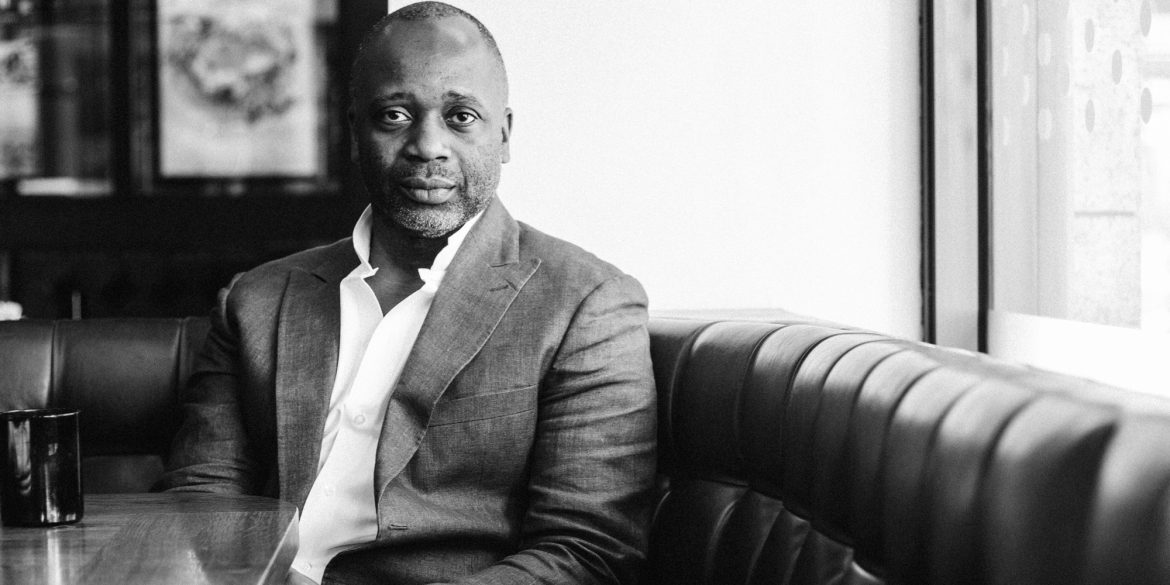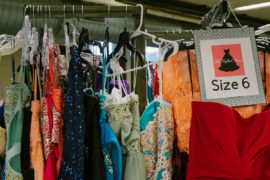This story originally appeared in VOL. 12 Fall 2017 print edition of Pattern Magazine.
Theaster Gates is making more than art. He’s creating a massive change in the way people around the world see art and its role in society. We meet to talk at a Chicago bar near Millennium Park. He orders a Negroni, Hendricks, shaken and on the rocks. Gates is a sharp dresser with tailored suits and leather shoes. His handshake is firm and he looks you in the eye as he speaks.
Though he doesn’t subscribe to the labels, Gates is generally considered a social practice artist and a creative placemaker. Basically, these are artists who make things happen socially, often in public spaces, versus focusing on making objects in a studio.
In some ways, the label fits. Gates is an artist interested in utopias. His degrees are in urban planning, setting him apart from most other social practice artists. “The reason I chose urban planning had to do with feeling I had no control over the city I lived in,” he says. “It should have offered me answers for the city. All it offered was that black people were the problem. So that created a little bit of self-hatred for a few years and a desire to prove my professors wrong.”
And he began to deploy an artist’s approach planning issues. “Once I started practicing, it was like, ‘Oh these problems actually require a creative deployment of this vocation. Not just a person who’s ready to do whatever for a large development or whatever for governance,’” he says. “It actually requires that you combine urban planning with a consciousness and some style.”
Dorchester Projects, one of his better-known works, is a cluster of formerly abandoned buildings on the south side of Chicago. When starting this work in 2009, Gates grasped and respected the history, the stories, and the memories — invisible to so many others — that lived in the brick and wood, metal and cement. With Dorchester, he’s worked with partners and collaborators to offer a library, a slide archive, and a soul food kitchen.
Another project, Stony Island Arts Bank — housed in what was once a crumbling structure a bit further south in Chicago — now features a hybrid gallery, media archive, library, and community center. And it intentionally offers hints of its past — both glimpses of former opulence and decay.
Repeatedly throughout his work you see his reverence for forgotten places, neighborhoods, and people. Gates calls it Real Estate Art.
“People told me over and over again with Stony Island Art Bank, tear it down. You could build the same amount of square footage for half the price. Who said this had anything to do with square footage? It has to do with having an adequate host,” Gates explains. “When I was restoring it, people from the Nation of Islam came to me and said, ‘We used to own this bank. We remember when the Nation was surrounding this building, when Louis Farrakhan would do his talks, we cashed our checks here.’ A reconstructed version doesn’t honor the Nation of Islam. When the host becomes invisible, man, you start to forget other parts.”
Gates was able to see the resting potential in forgotten places — and people. And he began to think about and make art. “I grew my aesthetic interests as a way of trying to articulate that it wasn’t about money. That people had class. That it wasn’t about money people had. It was about dignity. It was about a set of values that one cultivated. And that cultivated values even with a broke person are really sexy,” he says. “Like ‘I don’t have anything else but I have amazing roses.’ Those roses didn’t require money. They required time, knowledge and an awareness of the seasons. I think I got here because I had a deep interest in how things run and when they run, how beautiful they might be.”
His appreciation for craft goes back to his childhood. Made of roofing materials and an Ebony Magazine, his piece Ain’t I A Man was part of his exhibit My Labor Is My Protest. This references his father’s alternative form of protest, tarring roofs, during the 1968 Chicago riots.
Within the large-scale works that are buildings, Gates also creates objects, paintings and sculptures that sell in high-end galleries like White Cube in London. He uses the sale of these objects, in large part, to finance his building projects.
Gates has a strong interest in vessels, as demonstrated with his study of ceramics. His piece, Soul Manufacturing Corporation, is a combination of functional and non-functional ceramic objects with a nod to masters like Shoji Hamada. Even when they are turned into commodities, there are several layers of meaning in his work.
“My thoughts are symbols. There’s a set of images that live in my head, that don’t have a host. In some way the making is the ability to recall both things I remember and recall things that should be remembered. In different ways I have access to those things that have been seen by others but because they don’t have material form or because the material form is obscure or forgotten about there’s an opportunity to reintroduce the host,” he says. “When I use the word ‘host,’ I mean I need a glass for my water. That glass functions as a host and the glass allows me to have this other encounter with water that I couldn’t if it weren’t for that host.”
His pieces serve as a host of a history and ambition. Gates uses his tools to reinvent spaces and materials, reminding us of the soul we gave them — by being our best and worst selves.
“In art, it’s kind of like, ‘what’s the right host for the right set of images I want to pull from the world?’ I want to pull from my memory, pull from my daddy’s memory, pull from a kind of DNA history, pull from a traditional African religious history,” he says. “There’s always reconciling between the content that lives in my imagination and then how best to materialize that thing. Unfortunately, journalism might only call that a recycled object. But that dumbs down the thing I am after. The thing is that wood was a participant in the creation of a host structure that allowed people to catch the Holy Ghost over and over again for 42 years at this church. The wood is part of a material membership that enabled great things to happen that were invisible.”
In essence, Gates is a more than an artist, he’s a resurrectionist, a provider of second chances. Since so much of the African-American history has been ignored, destroyed and uncollected, his resurrections are essential to understanding what it means not only to be African-American but also human.




